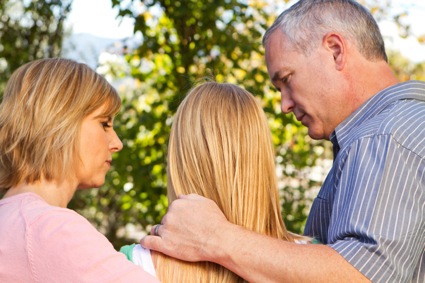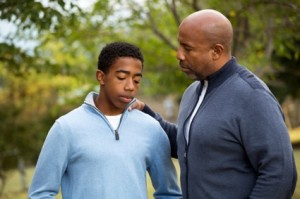Helping your child to effectively handle bullying
By Ritu Chandra, M.D.
This blog is part two in a two-part series about bullying. You can read the first part here, which describes the definition of bullying and warning signs that you may see if your child is either being bullied or bullying others.
This week, we will discuss the harmful, long-term effects of bullying as well as actions that parents can take to help their child understand, prevent or stop this behavior from occurring.
Effects of Bullying
Bullying can affect everyone—those who are bullied, those who bully, and those who witness bullying. Bullying is linked to many negative outcomes, including impacts on mental health, substance use, and suicide. It is important to talk to kids to determine whether bullying—or something else—is a concern.
Kids Who are Bullied
Kids who are bullied can experience negative physical, school, and mental health issues. Kids who are bullied are more likely to experience:
- Depression and anxiety, increased feelings of sadness and loneliness, changes in sleep and eating patterns, and loss of interest in activities they used to enjoy. These issues may persist into adulthood.
- Health complaints
- Decreased academic achievement—GPA and standardized test scores—and school participation. They are more likely to miss, skip, or drop out of school.
A very small number of bullied children might retaliate through extremely violent measures. In 12 of 15 school shooting cases in the 1990s, the shooters had a history of being bullied.
Kids Who Bully Others
Kids who bully others can also engage in violent and other risky behaviors into adulthood. Kids who bully are more likely to:
- Abuse alcohol and other drugs in adolescence and as adults
- Get into fights, vandalize property, and drop out of school
- Engage in early sexual activity
- Have criminal convictions and traffic citations as adults
- Be abusive toward their romantic partners, spouses, or children as adults
Bystanders
Kids who witness bullying are more likely to:
- Have increased use of tobacco, alcohol, or other drugs
- Have increased mental health problems, including depression and anxiety
- Miss or skip school
Prevent Bullying
Parents, school staff, and other adults in the community can help kids prevent bullying by talking about it, building a safe school environment, and creating a community-wide bullying prevention strategy.
Educate About Bullying
Training school staff and students to prevent and address bullying can help sustain bullying prevention efforts over time. I have personally done numerous staff training workshops for school staff at the beginning of the school year. I have also made presentations on bullying to several PTAs to address this very important issue.
Activities to Teach Students About Bullying
Schools don’t always need formal programs to help students learn about bullying prevention. Schools can incorporate the topic of bullying prevention into everyday lessons and activities. Examples of activities to teach about bulling include:
- Internet or library research, such as looking up types of bullying, how to prevent it, and how kids should respond
- Presentations, such as a speech or role-play on stopping bullying
- Discussions about topics such as reporting bullying
- Creative writing, such as a poem speaking out against bullying or a story or skit teaching bystanders how to help
- Artistic works, such as a collage about respect or the effects of bullying
- Classroom meetings to talk about peer relations
How to Talk About Bullying
Parents, school staff, and other caring adults have a role to play in preventing bullying. They can:
- Help kids understand bullying. Talk about what bullying is and how to stand up to it safely. Tell kids bullying is unacceptable. Make sure kids know how to get help.
- Keep the lines of communication open. Check in with kids often. Listen to them. Know their friends, ask about school, and understand their concerns.
- Encourage kids to do what they love. Special activities, interests, and hobbies can boost confidence, help kids make friends, and protect them from bullying behavior.
- Model how to treat others with kindness and respect.
Help Kids Understand Bullying
Kids who know what bullying is can better identify it. They can talk about bullying if it happens to them or others. Kids need to know ways to safely stand up to bullying and how to get help.
- Encourage kids to speak to a trusted adult if they are bullied or see others being bullied. The adult can give comfort, support, and advice, even if they can’t solve the problem directly. Encourage the child to report bullying if it happens.
- Talk about how to stand up to kids who bully. Give tips, like using humor and saying “stop” directly and confidently. Talk about what to do if those actions don’t work, like walking away.
- Talk about strategies for staying safe, such as staying near adults or groups of other kids.
- Urge them to help kids who are bullied by showing kindness or getting help.
Talking about bullying directly is an important step in understanding how the issue might be affecting kids. There are no right or wrong answers to these questions, but it is important to encourage kids to answer them honestly. Assure kids that they are not alone in addressing any problems that arise. Start conversations about bullying with questions like these:
- What does “bullying” mean to you?
- Describe what kids who bully are like. Why do you think people bully?
- Who are the adults you trust most when it comes to things like bullying?
- Have you ever felt scared to go to school because you were afraid of bullying? What ways have you tried to change it?
- What do you think parents can do to help stop bullying?
- Have you or your friends left other kids out on purpose? Do you think that was bullying? Why or why not?
- What do you usually do when you see bullying going on?
- Do you ever see kids at your school being bullied by other kids? How does it make you feel?
- Have you ever tried to help someone who is being bullied? What happened? What would you do if it happens again?
Support Kids Who are Bullied
Listen and focus on the child. Learn what’s been going on and show you want to help.
Assure the child that bullying is not their fault.
Know that kids who are bullied may struggle with talking about it. Consider referring them to a school counselor, psychologist, or other mental health service.
Give advice about what to do. This may involve role-playing and thinking through how the child might react if the bullying occurs again.
Work together to resolve the situation and protect the bullied child. The child, parents, and school or organization may all have valuable input. It may help to:
- Ask the child who is being bullied what can be done to make him or her feel safe. Remember that changes to routine should be minimized. He or she is not at fault and should not be singled out. For example, consider rearranging classroom or bus seating plans for everyone. If bigger moves are necessary, such as switching classrooms or bus routes, the child who is bullied should not be forced to change.
- Develop a game plan. Maintain open communication between schools, organizations, and parents. Discuss the steps that are taken and the limitations around what can be done based on policies and laws. Remember, the law does not allow school personnel to discuss discipline, consequences, or services given to other children.
Be persistent. Bullying may not end overnight. Commit to making it stop and consistently support the bullied child.
Avoid these mistakes:
- Never tell the child to ignore the bullying.
- Do not blame the child for being bullied. Even if he or she provoked the bullying, no one deserves to be bullied.
- Do not tell the child to physically fight back against the kid who is bullying. It could get the child hurt, suspended, or expelled.
- Parents should resist the urge to contact the other parents involved. It may make matters worse. School or other officials can act as mediators between parents.
Follow-up. Show a commitment to making bullying stop. Because bullying is behavior that repeats or has the potential to be repeated, it takes consistent effort to ensure that it stops.
Avoid strategies that don’t work or have negative consequences.
- Zero tolerance or “three strikes, you’re out” strategies don’t work. Suspending or expelling students who bully does not reduce bullying behavior. Students and teachers may be less likely to report and address bullying if suspension or expulsion is the consequence.
- Conflict resolution and peer mediation don’t work for bullying. Bullying is not a conflict between people of equal power who share equal blame. Facing those who have bullied may further upset kids who have been bullied.
- Group treatment for students who bully doesn’t work. Group members tend to reinforce bullying behavior in each other.
Follow-up. After the bullying issue is resolved, continue finding ways to help the child who bullied to understand how what they do affects other people. For example, praise acts of kindness or talk about what it means to be a good friend.
Dr. Ritu Chandra is the founder of Preferred Medical Group, with locations at Phenix City Children’s and Fort Mitchell Clinic. She is a board-certified pediatrician and specializes in ADHD, asthma, and school-related problems.
Photo Credit: istockphoto.com




